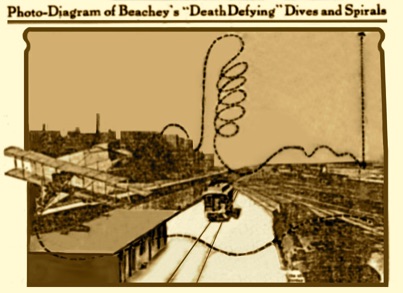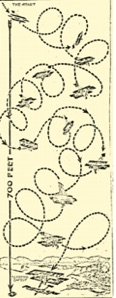....The feud between the Wright Brothers and Glenn Curtiss quickly reached a fever pitch after Wilbur died in 1912. Orville publicly lashed out declaring that Glenn Curtiss, not typhoid fever, as the stressful cause of his brother's death. Perhaps his bitter sadness tainted his conception of what was possible in aviation when in 1914 he disregarded and called impossible Lincoln Beachey's promotional proclamations of "Upside down flying and loop the loops" in a Curtiss style machine. Said Wright, "It is probably done high in the air, 3000 feet of so, an optical illusion and promoter's hype."
But Orville Wright, like everyone else, had not realized that Lincoln Beachey, "the flying fool" had matured and indeed fathered a new art form, aerial aerobatics. Here, upon the canvas of the sky, the master's instrument was "the first fully aerobatic flying machine", the Little Looper. The sky suddenly exploded with flying freedom, finally going every direction in perfect control, dancing and spinning, looping and out-flying the birds–and the Father of Aerobatics knew it.
"I want to show such men as Henry Ford, Thomas Edison and other inventive and manufacturing geniuses how I handle the Little Looper. I do not believe they dream such things are possible. Instead of being a reckless chance-taker, I am really the pioneer explorer of the unchartered air lanes of the sky... I want to open the eyes of the people to the possibilities of the aeroplane. My tour this summer will help advance the science of flying by ten years."
Indeed, seventeen million Americans saw Beachey dazzle the sky in his Little Looper in the 126 city tour of 1914. (May 12-Dec 31) Vast crowds were to "pack the parks to suffocation in every town," while ceremonial and grand entries into city after city confirmed that Lincoln Beachey was the "Alexander (The Great) of the Air" and had reached the very acme of American adoration. His "every day glory" was later compared to "Lindberg's triumphant return from Paris". And also in the summer of 1914, Lincoln Beachey got his wish to fly for Edison -- as told through the local newspaper.
BEACHEY'S STUNTS AMAZE EDISON
Thomas A. Edison declares that Beachey's loop-the-loop and upside-down flights are the greatest contributions to science since the Wright brothers first flew a heavier than air machine some ten years ago.
"I was startled and amazed," said Edison, "when I saw that youngster take to the sky and send his aeroplane though the loop and then follow that feat with an upside-down flight. I could not believe my own eyes and my nerves were a tingle for many minutes.
"Two years ago Orville Wright told me that man had done about all with the air-craft that could be done until the inventive genius provided some automatic balancing device calculated to act more quickly than man can think and act at the same time.
"Contrary to my impression, Beachey's loop was not performed high in the air, at a distance that would enhance the opportunity for a trick of legerdemain. But almost over my head he spun around, outraging all wonderful, so wonderful, in fact, that I was relieved when, after the third loop, Beachey came back to the earth.
"Then I spent a whole day figuring out how it was possible for a young aviator to be performing a feat the man who invented and flew the first aeroplane declared was impossible; there was sufficient food for thought, and deep thought at that. When I sought out young Beachey and asked him for an explanation, he looked at me in a quizzical manner and replied, 'I took you for my example and set out to do what others thought impossible. Then after studying it all out, I went at it and combined thought and action to a degree sufficient to get away with it.'
"That tells the whole story, doing what the other fellow declares impossible. And it is a rare sport doing it, too."
In Dayton, Ohio, Lincoln's perfection was acute for Orville Wright. Legend has it that he ended the show with ten consecutive loops, then flipping his machine on its back, flew it upwards until it stalled, fell tail first, backwards upside down, pulled his tail up until it stalled backwards upside down, and repeated this stunt–an upside down double 'Z'. It was similar to a falling leaf, but instead of side to side swinging this was fore and aft–all with his hands off the wheel, his arms wide like the bird that he was, controlling his machine with only his knees and torso. A convinced Wright had to concede Beachey's genius, "I have watched him closely with my glasses and have never seen him make an error or falter. An aeroplane in the hands of Lincoln Beachey is poetry. His mastery is a thing of beauty to watch. His performance not only surprised me, but amazed me as well. He is more magnificent than I imagined. Beachey is the most wonderful aviator the world has yet seen, indeed, the most wonderful of all."
Beachey's greatest detractor became an ardent admirer. His fans included poets Elbert Hubbard, "poet laureate of the people" who anointed Beachey as a great master.
"Each art has its master-worker -- its Paderewski, its Saint-Gaudens, its Michelangelo, its Milton. There is music and most inspiring grace and prettiest poesy in flight by man in the heavens. And posterity will write the name of Lincoln Beachey as the greatest artist on the aeroplane. In his flying is the same delicacy of touch, the same inspirational finesse of movement, the same developed genius of Paderewski and Milton."
An unknown poet in Chicago in 1912 was moved to cast into words the wonder he had seen in the air.
To Beachey 1912
Riding against the east,
A veering, steady shadow
Purrs the motor-call
Of the man-bird
Ready with the death-laughter
In his throat
And in his heart always
The love of the big blue beyond.
Only a man,
A far fleck of shadow on the east
Sitting at ease
With his hands on a wheel
And around him the large gray wings
Hold him, great soft wings,
Keep and deal kindly, O wings,
With the cool, calm shadow at the wheel.
–Carl Sandberg
Men and women may have operated flying machines in the air before Beachey –and with quite some flair–but it could be said that no one truly flew until Lincoln Beachey. Beachey was acclaimed as the first "Genius of Aviation", the first "Aerial Master", "Alexander of the Air", "the World's Greatest Aviator", and "Divine Flyer." He recalled overcoming the false barriers and presumptions of upside down flying and looping, "The instant I achieved the loop, death and I shook hands. It was then than man's courage, coupled with an invention of science, had finally solved the deep mystery which through the ages had surrounded the flight of birds."
Beachey is credited with inventing stall-recovery, is the first to achieve terminal velocity (by flying straight down), first to fly indoors, first to fly upside down, first to master the loop, first to tail-slide (on purpose), first to barrel roll, first to do a host of aerobatic routines. He broke state and national records for crowd sizes, set altitude and accuracy standards, and achieved a level of national and world fame that few have ever attained. Lincoln Beachey "was known by sight to hundreds of thousands and by name to the whole world."
At one point in 1913, so many other aviators died imitating Lincoln Beachey that a public cry went out for him to be forbidden to fly. Lincoln feared that he would be forgotten, that he would be thought of as a lucky fool: only he knew he was not foolishly off the path, but forging it. Beachey was forced, by public blame for all aviation deaths, to temporarily retire from aviation. While grounded, "the greatest of them all was tied to a little stage" but again he toured the nation on a vaudeville tour, explaining aviatic technicalities to the throngs that came to see him speak. He explained not only the present and past aviatic issues, he was often prophetic. "Some day we will be able to mount and ride any steed of the air, be he ever so tempestuous" . . . "It is not time yet to fly across the Atlantic, the mechanics are not there yet, otherwise I would do it" . . . "'flyabouts' will become a popular means of conveyance with the masses". . . "All wars will be decided from the air" . . . "In the air, the nations of the world will someday join hands".
Lincoln Beachey wasn't just the world's greatest aviator, he was a passionate American who worked tirelessly to promote aviation in the U.S. In 1914, Russia had over 1500 planes in its military, Germany and France each built over a 1000, Mexico carried 400, while the United States government poorly maintained 23. Beachey passed out millions of brochures powerfully urging readers to write their Congressman and enact real aviatic investment. Beachey personally and publicly petitioned the government to let him give them a demonstration. But when the invitation came and only two cabinet members arrived to the exhibition, Beachey knew he must break the rules if he was to get everyone to watch.
Legend has it that President Wilson was working on neutrality papers in the Oval Office when he heard what he thought was a fly. Picking up his swatter, he began to stalk the intruder. But the buzzing got louder and appeared to be coming from outside. Wilson looked out his window and saw, heading for the windows of the Oval Office like an arrow for a bull's eye, an 800 pound biplane with the pilot out front staring directly at him. Wilson broke into a sweat when he and the pilot could see each other quite clearly, eye to eye, and the plane did not waver from its deadly course. At the last possible moment, Lincoln pulled his machine straight up and spun his machine, flashing his name written across the wings, B-E-A-C-H-E-Y. The birdman climbed above the White House, looped back and dove at it again and again as if on a bombing run of complete devastation. The crowds formed everywhere below, filling the Mall, filling all the streets and rooftops, arresting the entire town.
Lincoln dived toward the Mall, pulled up just a scant 100 feet above the amazed onlookers, flipped his machine over and flew upside down past the Washington Monument. Every set of eyes was fixed upwards to see written upon his top wing what the President had read, B-E-A-C-H-E-Y, as he shot like a lightning bolt across the sky, headed straight for the Capitol.
He was determined that every legislator would see the genius of aviation, and know the power of the aeroplane.
Congress adjourned to witness the spectacle. Lincoln attacked the capitol again and again, and ended his flight by waving his wings to Congress. The lawmen cheered him as he flew back to the polo field across from the White House. After quickly refueling, he climbed to 3000 feet and performed another aerial ballet. Suddenly, he seemed to be stuck upside down, and worse, his motor quit and he began to fall and spin! He dropped out of the sky in a deadly upside-down spiral, and from a distance, did not seem to pull out of it. Personnel at the Army hospital saw the aviator fall and rushed out with ambulances. Telegraph operators also witnessed the fall and instantly tapped out the news to the nation: Lincoln Beachey was dead!
It was reported that at the polo field Secretary Daniels was congratulating Lincoln when they heard someone yelling, "Make way, move aside," and saw the crowds parting. The Army medics broke into the open surrounding the aeroplane, looked frantically in all directions and asked in confusion, "Where's the crash?"
Beachey smiled and asked, "What crash?"
The medics were dumbfounded at the crowd's seeming lack of concern: "We saw a plane crash over here!"
Beachey feigned insult. "That was no crash," the sky-master said, proudly putting his hands on his hips. "I always land that way."
Beachey let it be loudly known, "If I had had a bomb, you would be dead. You were defenseless. It is time to put a force in the air."
The editors of Aero and Hydro, the country's leading voice of American aviation, lauded Beachey's aerial demonstration as an heroic act which had forced the government to recognize the necessity of their involvement in the new technology of aviation.
"While Beachey's flights were unofficially "official," Aero and Hydro cannot but believe that American aviation has been given a distinct impetus that will be incalculable in its benefits. Such a forceful and practical demonstration before the Members of our Congress cannot fail of great good to all directly or indirectly concerned in our great aeronautic movement and we venture the prediction that its future stability is marked from this event.
When the heads of the fighting men of the country and their staffs, and the Senators and Congressmen exhibit the enthusiasm we could not help but witness after the flights, when the Capitol is set all agog on the subject of aviation and evidences of greater Military and Naval aero activity immediately blossom forth, we cannot help but extend our best congratulations to Lincoln Beachey, "the agnostic of rational flying," so often falsely decried as a distinct menace to the science of flight, on his brilliant work and his magnanimous co-operation in this effort to wake up the country to things aviatic and create a demand for meritorious "made-in-America" aeronautic products."
Many lawmakers sent expressions of gratitude to Lincoln for opening their eyes to the development of air power. Congress proposed that San Francisco be the site of the first governmental aero post in America under the direction of California's premier aviator. Lincoln was honored by the proposal, but having already committed himself to headlining the upcoming World's Fair, he declined taking up the position. Still, the die was cast, and Congress finally began appropriating significant dollars to the creation of a force in the air.
The cynics who for years had called Lincoln "crazy" and "dangerous" were silenced by the government's recognition of his aeronautical genius. Many of the country's top aviators endorsed Beachey's stalwart leadership, and newspaper editorials everywhere gave unparalleled accolades to the master of the air. An editorial from a St. Louis paper summarized the public's sentiment toward America's most popular hero:
So what happened? With stature far surpassing his contemporaries and even later Lindberg, the name of Lincoln Beachey fell into common obscurity. Why or how could it happen?
The reasons are many and I will attempt to elucidate the main themes, why I think this could have happened. Firstly, Beachey suffered the genius' misunderstanding , and did not receive his full recognition until near the end of his life -- for years he fought the "crazy fool" label. "Well, listen. The people demanded thrills in the first place. I was never egotistical enough to think that the crowds came to witness my skill in putting a biplane through all the trick-dog stunts. There was only one thing that drew them to my exhibitions -- the desire to see "something happen" -- meaning, of course, my death. They all predicted that I would be killed while flying, and none near wanted to miss being at the death if they could help it. They paid to see me die. They bet I would, and the odds were always against my life, and I got big money for it."
Beachey's most famous weakness was "too many women". He had a girlfriend in most major American cities, and in many larger towns as well. In those days, sex was out of the question unless you were at least engaged to be married. To maintain some social face, Beachey literally bought diamond engagement rings by the dozen– and he always kept one in his vest pocket, in case the need arose. (He finally met his match, however, in Merced Walton and was truly engaged to be married.) Beachey's free sexuality did not exactly make him posterity material in the eyes of the common decree.
Beachey's biggest blunder as far as posterity is concerned was the lousy timing of his death. The nations of the world had gathered for the World's Fair in Beachey's hometown of San Francisco and were presenting him with a gold medal for his contributions to aviation when, on his demonstration flight, the wings of his new plane folded backwards at the bottom of a dive and he smashed into the SF Bay at somewhere near 200mph. He survived the crash, but was trapped in his machine (evidenced by struggle to get free) and Lincoln Beachey drowned in front of a quarter of a million people.
Beachey's death was world news at the time, San Francisco's phone system jammed for 24 hours, and the news flashed on movie screens all across America. The mayor of San Francisco personally took care of all arrangements for what was said to be the largest funeral in San Francisco's history. Thousands lined the streets, the prestigious Olympic Club (of which Beachey was a member) carried the casket, and "the greatest of them all" was buried just at the outset of World War I. His grand memorials were delayed until after "the European skirmish" was under control. Well, the skirmish became World War I and five years went by before the first offficial Beachey's memorials (which went on for years). The original name of the SF airport was originally purposed to be The Lincoln Beachey Memorial Flying Park. Thousands came to the yearly memorials, the President sent telegrams, Col. Hap Arnold was master of ceremonies, Eddie Rickenbaker flew the plane which dropped Beachey's favorite, pink roses, but in light of the new war heroes, the rascal genius was easily forgotten. The Trans-Atlantic flight of Charles Lindberg gave the aviation-hero business a fresh face. Then the Great Depression and another World War pushed the name of Lincoln Beachey into relative obscurity.
America forgot one of its greatest heroes. A superstar and true pioneer of gigantic proportions fell from common knowledge, though many, many books acknowledge him as the greatest of all the early aviators. Many museums and aviation historians likewise acknowledge the Father of Aerobatics, but until recently, Lincoln Beachey remained mainly in his grave.
THE RESURRECTION
Author Frank Marrero wrote a biography Lincoln Beachey: Them Man Who Owned the Sky which has been well received and highly praised. On March 15th, 1998 "Beachey Day" as it had long been known in the City by the Bay, San Francisco again celebrated Beachey Day. The Coast Guard blocked off a 1/2 square mile of the Bay as Half Moon Bay's Eddie Andreinni recreated a Beachey airshow in his 1939 Stearman biplane. The Honorable Mayor Willie Brown anointed with champagne a plaque to Lincoln Beachey down at the Marina, (on the east end of Crissy Field) where Mayor Brown announced there was to be a Lincoln Beachey Plaza built. Antique airplanes flew by dropping Beachy's pink rose petals.
The Hiller Museum of Northern California Aviation History, (just 8 miles south of the San Francisco Airport at the San Carlos airport) is California's newest and largest aviation museum. This world class museum features Lincoln Beachey's Little Looper and probably the largest collection of Beachey material in the world.
And while you are in the area, visit Beachey's grave in nearby Colma, in the last of the great Victorian graveyards: the breath-taking Forest Lawn Cemetery.
When we remember the past and honor our forerunners, we inherit their strength, wisdom, and power. History's estate is given to those who honor their foundation. Then our forgetting of this aerial giant will be over -- and whoever does the work of remembrance will breathe in a great pleasure.
*****
References for all the material in this article came from Lincoln Beachey: The Man Who Owned the Sky.
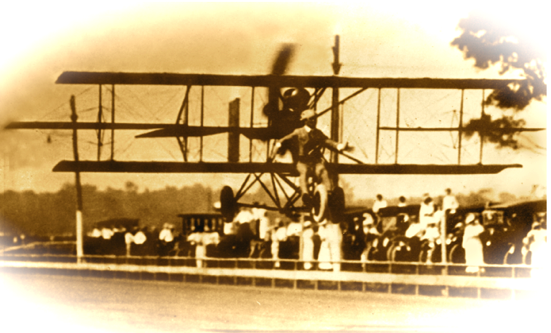
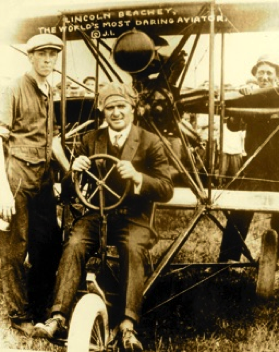
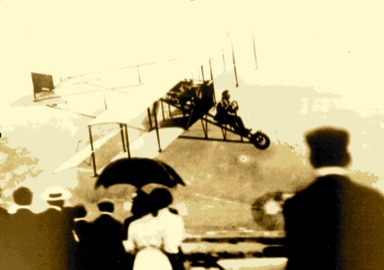
When a person talks aviation or aviators, 90 people out of every 100 instinctively say, "You know I saw Beachey at such and such place?" or "Did you ever see Beachey fly?" Why is it that Beachey is unique in being uppermost in the minds of everyone whom sky flying is talked of? Why is it today that Beachey is the only aviator in North America who can play any type of city or town, and unaided, pack the parks and tracks and grandstands to suffocation?
The principal reason that Lincoln Beachey is to aviation what Marshall Field's is to the dry goods trade, what the Imperator is to the shipping world, what Richard Mansfield was to the American dramatic stage. He is the big, central figure. In the esteem of the public he stands alone.
A serious accident to Beachey would wound the people of America more deeply than Beachey would be hurt. There is genuine affection for him in the hearts of the American people. He is our standard, as far as aviation is concerned. Long may he wave.
People no longer hold up Wright or Curtiss as examples of greatness in the mastery of the sky.
This is a Beachey age.
If Lincoln Beachey was flying from one park and twenty-four other aviators were flying in unison in a park across the street, the public would flock to see Beachey perform. It has been proven time and time again.
Beachey did not achieve his present prominence or vogue without the hardest kind of struggle. He served a cold apprenticeship. But he was brave, unassuming, persistent. He was both a dreamer and a realist. He dreamed the "loop" five years ago and when he told Glenn Curtiss and Bleriot and the other world figures of aviation of his ideas they laughed at him. Then, Pegoud, at Marseilles, France, performed the "loop" and astonished the scientific world. Out of his retirement came Beachey and in four months he not only turned the first "loop" in America, but did Pegoud 'one better'. Then he perfected his "death drop," falling from the clouds from 5,000 feet with a dead motor, throwing the machine over and flying upside-down. It took him three months to perfect the "death drop." In that three months he could have filled his purse by playing two scores of exhibitions and depending on his trick flying and "looping" for drawing cards.
But Beachey does not figure time or money as opposed to being in a class by himself. He stayed at the San Diego Aviation field for months and perfected this drop, and when he came east last May he was in a position to present a program which since that time has thrilled millions all over the eastern states, and which has more firmly than ever established him as the greatest aviator the world has ever known."

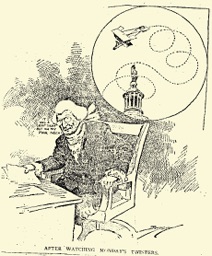
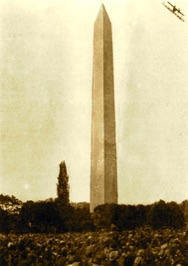

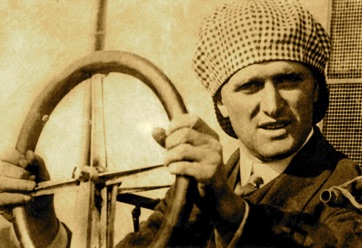
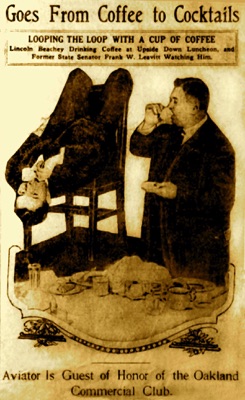
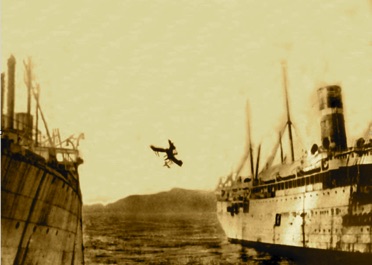
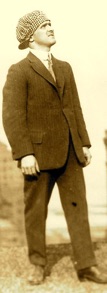
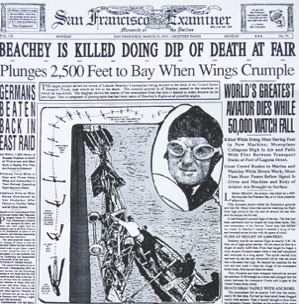
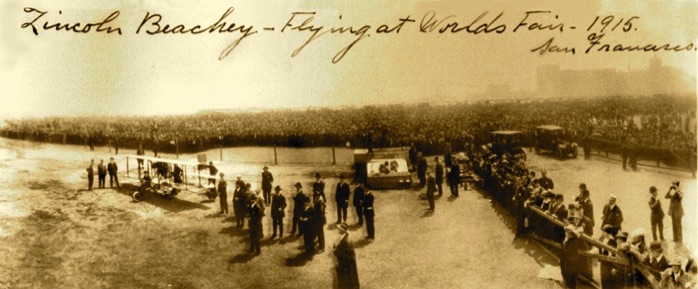
Enter Text
